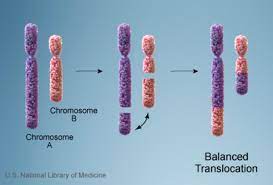 Refers to a chromosome abnormality caused by rearrangement of parts between nonhomologous chromosomes.
Refers to a chromosome abnormality caused by rearrangement of parts between nonhomologous chromosomes.
A gene fusion may be created
When the translocation joins two otherwise-separated genes, a gene fusion may be created, which occurs commonly in cancer.
Detected by cytogenetic studies.
Translocations can be balanced or unbalanced, and in the latter case the exchange of chromosome material is unequal resulting in extra or missing genes.
Reciprocal translocations refers to an exchange of material between nonhomologous chromosomes, and occur in about 1 in 500 to 1 in 625 newborns.
Reciprocal translocations are usually harmless and can be identified via prenatal diagnosis techniques.
Carriers of balanced reciprocal translocations have increased risks of creating gametes with unbalanced chromosome translocations, leading to miscarriages or children with abnormalities.
While most balanced translocation carriers have no symptoms and are healthy 6% have symptoms that may include autism, intellectual disability, or congenital anomalies.
Balance translocation carriers that have a gene disruption at the at the breakpoint may cause these problems.
Chromosomal translocations that occur in gametogenesis, due to errors in meiosis, occurs in all cells of the offspring.
Somatic translocations result in abnormalities only in the affected cell line, as in the Philadelphia chromosome translocation of chronic myelogenous leukemia.
Robertsonian translocation refers to a type of reciprocal translocation caused by breaks at or near the centromeres of two acrocentric chromosomes.
In Robertsonian translocations the reciprocal exchange of parts results in one large metacentric chromosome and one extremely small chromosome.
The small chromosome contains few genes.
Robertsonian translocation resulting karyotype leaves only 45 chromosomes, as two chromosomes have fused.
Robertsonian translocations can involving all combinations of acrocentric chromosomes.
The most common translocation in humans involves chromosomes 13 and 14.
Translocation of chromosomes 13 and 14 is seen in about 0.97 /1000 of newborns.
Carriers of Robertsonian translocations are not associated with phenotypic abnormalities.
Carriers of Robertsonian translocations are associated with a risk of unbalanced gametes that lead to miscarriages or abnormal offspring.
Carriers of Robertsonian translocations involving chromosome 21 have a higher chance of having a child with Down syndrome.
Problems caused by translocations include: acute myelogenous leukemia, chronic myelogenous leukemia, Ewing’s sarcoma, infertility, Down syndrome, and XX male syndrome,
Down syndrome in a minority of cases, less than 5%, can be caused by a Robertsonian translocation of the chromosome 21 long arm onto the long arm of chromosome 14.
The International System for Human Cytogenetic Nomenclature (ISCN) is used to denote a translocation between chromosomes.
The designation t(A;B)(p1;q2) is used to denote a translocation between chromosome A and chromosome B.
The information in the second set of parentheses denotes the precise location within the chromosome for chromosomes A and B respectively—with p indicating the short arm of the chromosome, q indicating the long arm, and the numbers after p or q refers to regions, bands and subbands seen when staining the chromosome.
